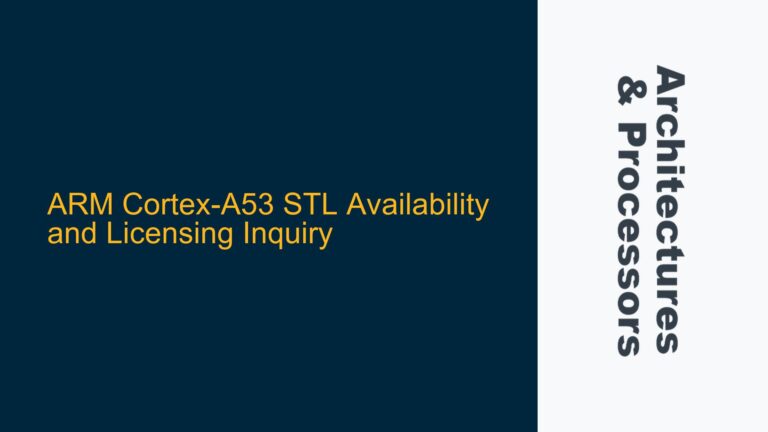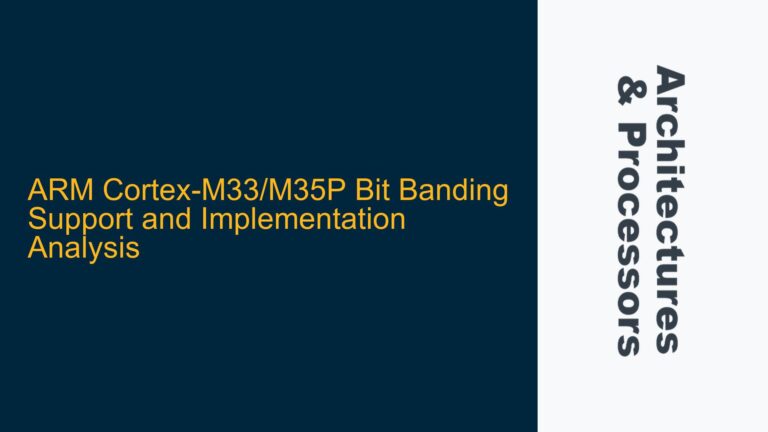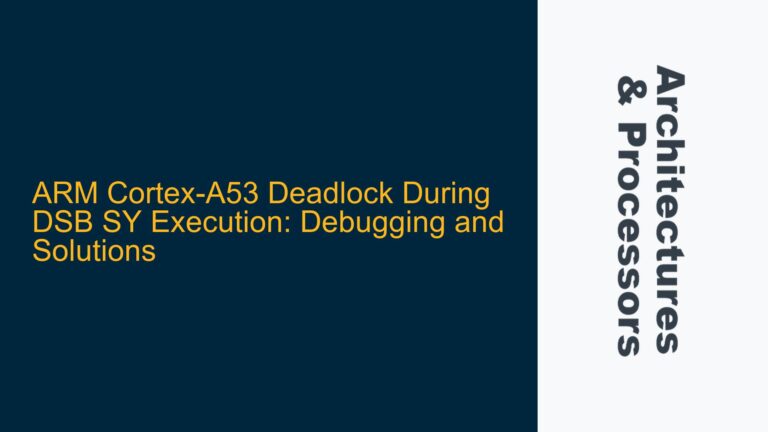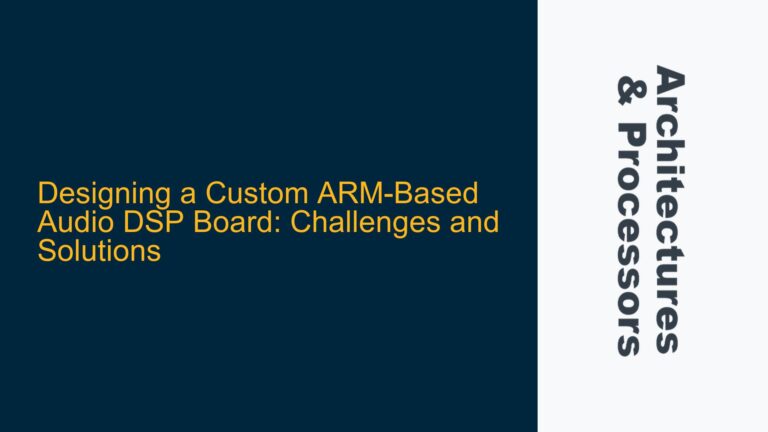ARM Cortex-M4 Branch Instruction Encoding: T3 vs. T4 Confusion and Resolution
The ARM Cortex-M4 architecture, like other ARM Cortex-M processors, utilizes the Thumb-2 instruction set, which combines 16-bit and 32-bit instructions to achieve a balance between code density and performance. Among the most critical instructions in any processor architecture are branch instructions, which control program flow. In the Cortex-M4, branch instructions such as B (unconditional branch) and Bcc (conditional branch) have multiple encodings, specifically T3 and T4, which are used depending on the range of the branch target and the specific conditions of the instruction. However, the encoding of these instructions, particularly the handling of the J1 and J2 bits in the immediate value, has led to confusion and potential misinterpretation. This post delves into the intricacies of T3 and T4 encodings, their differences, and how to correctly interpret and implement them.
T3 and T4 Encoding Differences in Branch Instructions
The T3 and T4 encodings for branch instructions in the ARM Cortex-M4 architecture are designed to handle different ranges of branch targets. The T3 encoding supports a 20-bit immediate value, while the T4 encoding supports a 24-bit immediate value. The primary difference between the two encodings lies in how the J1 and J2 bits are handled in the immediate value calculation.
In the T3 encoding, the immediate value is constructed as follows:
imm32 = SignExtend(S:J2:J1:imm6:imm11:'0', 32);
Here, S is the sign bit, J1 and J2 are bits that help extend the range of the branch target, and imm6 and imm11 are additional immediate value bits. The J1 and J2 bits are directly used in the immediate value calculation, and their order is straightforward.
In contrast, the T4 encoding uses a more complex formula:
I1 = NOT(J1 EOR S);
I2 = NOT(J2 EOR S);
imm32 = SignExtend(S:I1:I2:imm10:imm11:'0', 32);
Here, I1 and I2 are derived from J1 and J2 using an XOR operation with the sign bit S, followed by a NOT operation. This inversion mechanism is what causes confusion, as it appears to reverse the order of the J1 and J2 bits compared to the T3 encoding.
The key point of confusion arises from the fact that the J1 and J2 bits in the T4 encoding are not directly used in the immediate value calculation. Instead, they are transformed into I1 and I2 through the XOR and NOT operations. This transformation is necessary to ensure that the branch target address is correctly calculated, especially for longer-range branches. However, this additional layer of complexity can lead to misinterpretation, particularly when comparing the T3 and T4 encodings side by side.
Potential Misinterpretation and Its Implications
The primary issue with the T3 and T4 encodings lies in the potential for misinterpretation of the J1 and J2 bits. In the T3 encoding, the J1 and J2 bits are directly used in the immediate value calculation, making their role straightforward. However, in the T4 encoding, the J1 and J2 bits are transformed into I1 and I2 through the XOR and NOT operations, which can lead to confusion about their actual role in the encoding.
This confusion can have several implications. First, it can lead to incorrect hand-decoding of branch instructions, particularly when analyzing disassembled code or debugging at the assembly level. If the J1 and J2 bits are misinterpreted, the calculated branch target address will be incorrect, leading to unexpected program behavior. Second, it can lead to errors in assembler implementations, where the assembler may incorrectly encode the J1 and J2 bits, resulting in incorrect machine code. This is particularly problematic in cases where the assembler does not properly handle the transformation of J1 and J2 into I1 and I2 in the T4 encoding.
Another potential issue is the inconsistency in documentation. While the ARM Architecture Reference Manual provides detailed descriptions of the T3 and T4 encodings, the transformation of J1 and J2 into I1 and I2 in the T4 encoding is not always intuitively explained. This can lead to misunderstandings, particularly for developers who are new to the ARM architecture or who are not familiar with the intricacies of the Thumb-2 instruction set.
Correct Interpretation and Implementation of T3 and T4 Encodings
To correctly interpret and implement the T3 and T4 encodings for branch instructions, it is essential to understand the role of the J1 and J2 bits and how they are transformed in the T4 encoding. The following steps outline the correct approach to handling these encodings:
-
Understanding the Immediate Value Calculation: In both T3 and T4 encodings, the immediate value is used to calculate the branch target address. The immediate value is sign-extended to 32 bits, and the target address is calculated as the current program counter (PC) plus the sign-extended immediate value. The key difference lies in how the
J1andJ2bits are used in this calculation. -
Handling the T3 Encoding: In the T3 encoding, the
J1andJ2bits are directly used in the immediate value calculation. The immediate value is constructed as follows:imm32 = SignExtend(S:J2:J1:imm6:imm11:'0', 32);Here,
Sis the sign bit,J1andJ2are the extension bits, andimm6andimm11are additional immediate value bits. The order ofJ1andJ2is straightforward, and they are directly used in the calculation. -
Handling the T4 Encoding: In the T4 encoding, the
J1andJ2bits are transformed intoI1andI2using the following formulas:I1 = NOT(J1 EOR S); I2 = NOT(J2 EOR S); imm32 = SignExtend(S:I1:I2:imm10:imm11:'0', 32);Here,
Sis the sign bit, andI1andI2are derived fromJ1andJ2using the XOR and NOT operations. This transformation ensures that the branch target address is correctly calculated for longer-range branches. It is important to note that theJ1andJ2bits are not directly used in the immediate value calculation in the T4 encoding; instead, they are transformed intoI1andI2. -
Verifying Assembler Output: When working with assemblers, it is crucial to verify that the assembler correctly handles the T3 and T4 encodings. This can be done by examining the disassembled output of the generated machine code and comparing it with the expected encoding. If the assembler does not correctly handle the transformation of
J1andJ2intoI1andI2in the T4 encoding, it may be necessary to manually adjust the assembly code or use a different assembler. -
Debugging and Disassembly: When debugging or disassembling code, it is important to correctly interpret the
J1andJ2bits in the T3 and T4 encodings. In the T3 encoding, theJ1andJ2bits are directly used in the immediate value calculation, while in the T4 encoding, they are transformed intoI1andI2. Misinterpreting these bits can lead to incorrect branch target addresses, which can cause unexpected program behavior. -
Documentation and Reference: Always refer to the ARM Architecture Reference Manual for the most accurate and detailed information on the T3 and T4 encodings. The manual provides comprehensive descriptions of the encoding formats and the role of each bit in the instruction. If there is any confusion or ambiguity, consulting the manual can help clarify the correct interpretation and implementation of the encodings.
By following these steps, developers can ensure that they correctly interpret and implement the T3 and T4 encodings for branch instructions in the ARM Cortex-M4 architecture. This will help avoid potential issues related to incorrect branch target addresses and ensure that the program behaves as expected.
Practical Example: Encoding and Decoding a Branch Instruction
To further illustrate the correct handling of the T3 and T4 encodings, let’s consider a practical example of encoding and decoding a branch instruction. Suppose we have the following assembly code:
bne .+0b010011110000111101010 + 4
b .+0b0100111100001111011001010 + 4
The first instruction is a conditional branch (bne), which uses the T3 encoding, while the second instruction is an unconditional branch (b), which uses the T4 encoding. Let’s break down the encoding and decoding process for each instruction.
Encoding the Conditional Branch (T3 Encoding)
For the conditional branch instruction bne .+0b010011110000111101010 + 4, the immediate value is calculated as follows:
imm32 = SignExtend(S:J2:J1:imm6:imm11:'0', 32);
Assuming S is 0 (positive offset), J1 is 1, J2 is 0, imm6 is 010011, and imm11 is 11000011110, the immediate value is constructed as:
imm32 = SignExtend(0:0:1:010011:11000011110:'0', 32);
The resulting 32-bit immediate value is:
0000 0000 0000 0000 0100 1111 0000 1111 0101 0000
This value is then added to the current PC to calculate the branch target address.
Encoding the Unconditional Branch (T4 Encoding)
For the unconditional branch instruction b .+0b0100111100001111011001010 + 4, the immediate value is calculated as follows:
I1 = NOT(J1 EOR S);
I2 = NOT(J2 EOR S);
imm32 = SignExtend(S:I1:I2:imm10:imm11:'0', 32);
Assuming S is 0 (positive offset), J1 is 1, J2 is 0, imm10 is 0100111100, and imm11 is 00111101100, the immediate value is constructed as:
I1 = NOT(1 EOR 0) = 0;
I2 = NOT(0 EOR 0) = 1;
imm32 = SignExtend(0:0:1:0100111100:00111101100:'0', 32);
The resulting 32-bit immediate value is:
0000 0000 0000 0000 0100 1111 1000 1111 0110 0101 0000
This value is then added to the current PC to calculate the branch target address.
Decoding the Branch Instructions
When disassembling the machine code, the process is reversed. For the T3 encoding, the J1 and J2 bits are directly extracted from the instruction and used in the immediate value calculation. For the T4 encoding, the J1 and J2 bits are derived from I1 and I2 using the inverse of the XOR and NOT operations:
J1 = NOT(I1) EOR S;
J2 = NOT(I2) EOR S;
This ensures that the original J1 and J2 bits are correctly recovered and used in the immediate value calculation.
By carefully following these steps, developers can ensure that they correctly encode and decode branch instructions in the ARM Cortex-M4 architecture, avoiding potential issues related to incorrect branch target addresses.
Conclusion
The T3 and T4 encodings for branch instructions in the ARM Cortex-M4 architecture are designed to handle different ranges of branch targets, with the T4 encoding providing a longer range through a more complex immediate value calculation. The key difference between the two encodings lies in the handling of the J1 and J2 bits, which are transformed into I1 and I2 in the T4 encoding using XOR and NOT operations. This transformation can lead to confusion and potential misinterpretation, particularly when comparing the T3 and T4 encodings side by side.
To correctly interpret and implement these encodings, it is essential to understand the role of the J1 and J2 bits and how they are transformed in the T4 encoding. By carefully following the steps outlined in this post, developers can ensure that they correctly encode and decode branch instructions, avoiding potential issues related to incorrect branch target addresses. Additionally, verifying assembler output and consulting the ARM Architecture Reference Manual can help clarify any confusion and ensure accurate implementation of the T3 and T4 encodings.
In summary, while the T3 and T4 encodings for branch instructions in the ARM Cortex-M4 architecture may appear complex, a thorough understanding of their encoding formats and the role of each bit in the instruction can help developers navigate these complexities and ensure correct program behavior.






